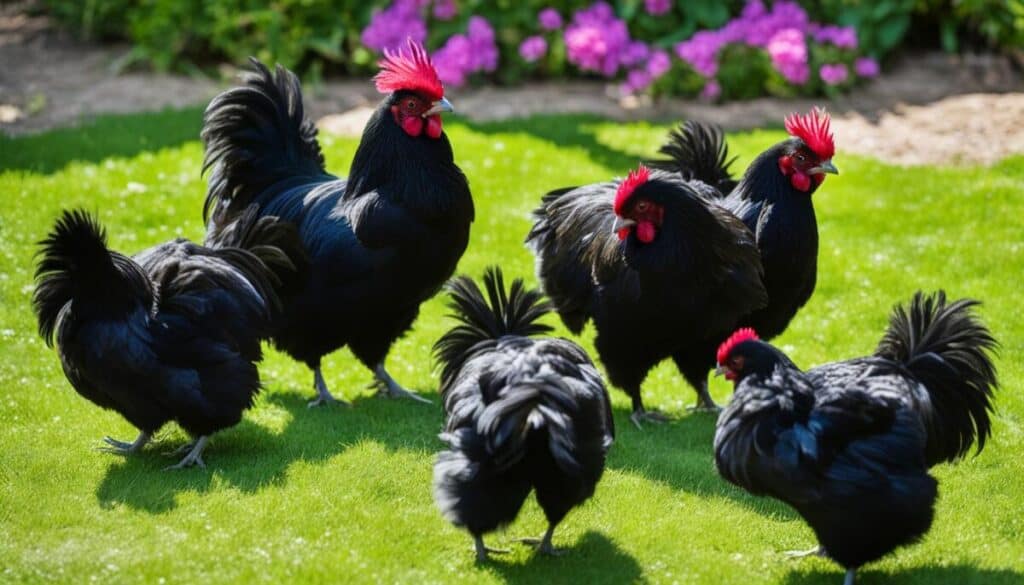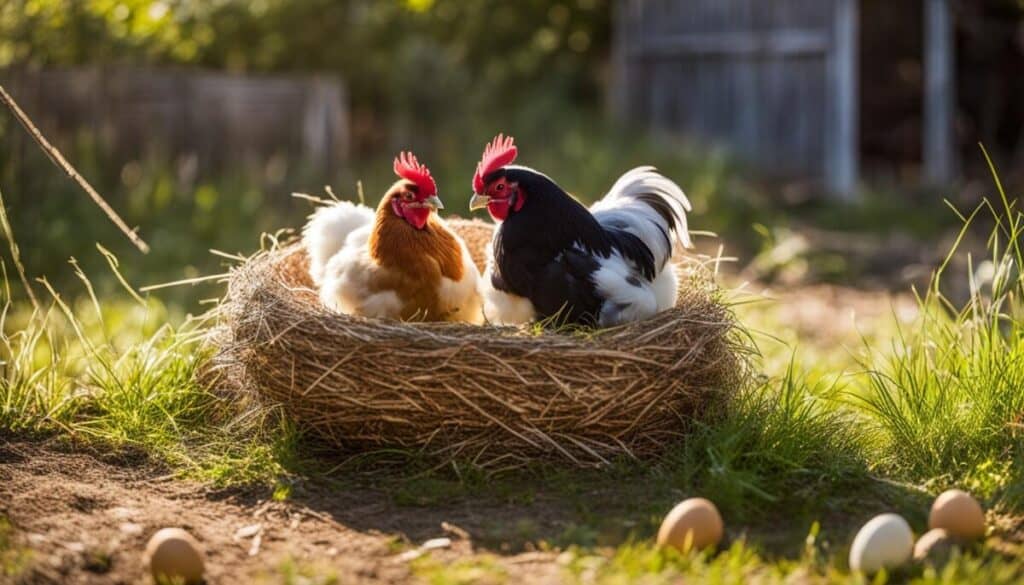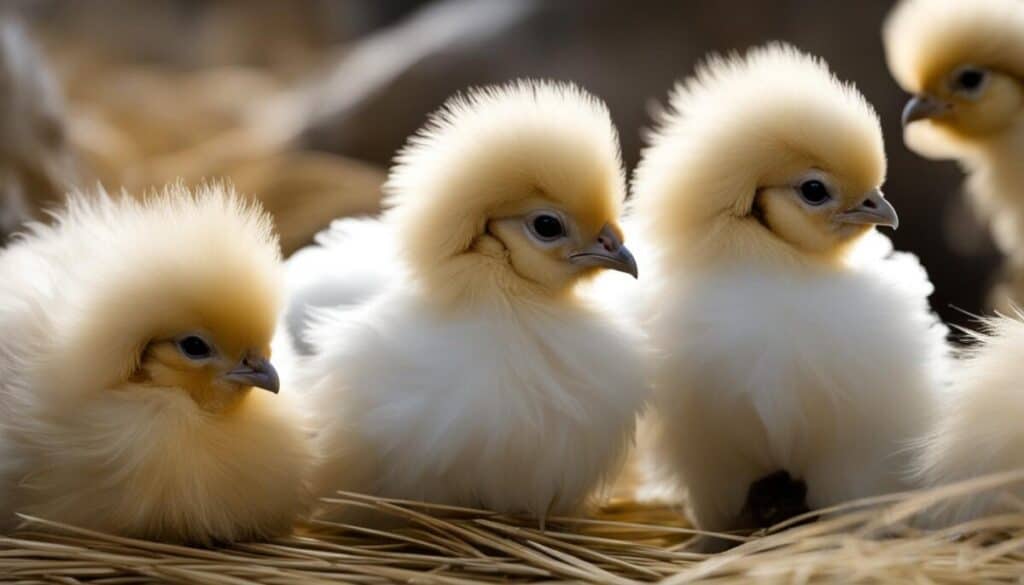If you’re considering raising Silkie Chickens, it’s essential to understand their care requirements and health needs. These cute and fluffy birds are known for their unique features and docile personalities, making them a popular choice for backyard flocks.
In this guide, we’ll provide you with comprehensive information on how to care for your Silkie Chickens, from housing and feeding to grooming and health maintenance. We’ll also cover common health issues and offer tips on how to address them.
Key Takeaways:
- Silkie Chickens require specific care, including appropriate housing and nutritional balance.
- Grooming is an essential aspect of Silkie Chicken care, including regular maintenance of their distinctive feathers.
- Regular health check-ups and vaccinations are essential to maintain their health.
- Common health issues that Silkie Chickens may face include respiratory infections, parasites, and egg-related problems.
- With proper care and attention, Silkie Chickens are a joy to have around and can provide a steady source of fresh eggs.
Getting to Know Silkie Chickens
If you are considering adding Silkie Chickens to your backyard flock, it’s essential to know what sets them apart from other chicken breeds. Here’s what you need to know:
Origins
Silkie Chickens are believed to have originated in China over 2,000 years ago. They were prized for their unique appearance and were often kept by Chinese nobility. In the 13th century, they were brought to Europe along the Silk Road trade network, where they quickly gained popularity.
Appearance
Silkie Chickens are easily recognizable for their fluffy feathers, which have a soft, fur-like texture. They have black skin, bones, and meat, which make them a delicacy in some parts of the world. They come in a variety of colors, including white, black, blue, and gray.
Unique Features
Silkie Chickens are known for their unique features. They have five toes on each foot, whereas most chicken breeds only have four. They also have a crest of feathers on their heads, which gives them a distinctive look. Silkie Chickens are also known for their calm and friendly personalities, which make them popular pets.
Housing and Bedding for Silkie Chickens
Silkie Chickens are unique in many ways, and their housing requirements are no exception. To ensure that your Silkies are happy and healthy, it’s essential to provide them with adequate housing and bedding. The size and design of the coop can have a significant impact on their well-being, so it’s essential to get it right. A good rule of thumb is to provide at least 2-3 square feet of space per bird, with plenty of natural light and good ventilation. (Silkie Chickens housing)
When it comes to bedding materials, there are several options to choose from. However, it’s crucial to select a product that’s safe, non-toxic, and absorbent. Some popular bedding materials include straw, wood shavings, and pine pellets. It’s important to replace the bedding frequently to ensure cleanliness and avoid respiratory issues. Additionally, providing a dust bath area with sand and diatomaceous earth can help keep Silkies clean and healthy. (Silkie Chickens bedding)
Silkie Chickens Housing and Bedding Comparison
| Bedding Material | Pros | Cons |
|---|---|---|
| Straw | Cheap, readily available, natural-looking | Absorbs moisture poorly, can be difficult to clean and dispose of |
| Wood Shavings | Larger flakes absorb moisture well, masks odors effectively | Dust can cause respiratory issues, not readily available in some areas |
| Pine Pellets | Highly absorbent, masks odors naturally, easy to clean | Somewhat costly, not as aesthetically pleasing as straw for some |
In conclusion, providing suitable housing and bedding materials is crucial for maintaining the health and comfort of Silkie Chickens. Don’t be afraid to experiment with different materials to find what works best for your flock. With good care and attention, your Silkies are sure to be happy and healthy for years to come.
Feeding Silkie Chickens
Silkie Chickens have specific nutritional needs that owners must meet to ensure their health and well-being. Silkie Chickens will thrive on a high-quality commercial feed specifically formulated for chickens, such as [brand name]. The feed should be a minimum of 16% protein and have a balanced ratio of vitamins and minerals suitable for this breed.
Additionally, it is essential to provide access to clean water at all times. Waterers should be checked daily and refilled often, especially during hot weather when Silkie Chickens may need additional hydration.
While commercial feed is essential, owners can supplement the diet with treats such as fruits, vegetables, and even mealworms or crickets. However, treats should not exceed 10% of the chicken’s diet to maintain a balanced diet.
Supplements such as oyster shells can be given to hens to provide additional calcium support for healthy egg production. Owners should ensure that these supplements are offered free-choice in separate containers.
It is best to feed Silkie Chickens in the morning to allow them to forage throughout the day. Any leftover food should be removed to prevent attracting pests and promoting hygiene in the coop.
Grooming and Health Maintenance for Silkie Chickens
Silkie Chickens are beloved for their unique feathers, but taking proper care of them requires attention to their grooming and health needs. Keeping your Silkie chickens healthy and happy is essential for the longevity of their lifespan. In this section, we’ll cover tips for grooming your Silkie Chickens and general health practices for maintaining their well-being.
Grooming Your Silkie Chickens
Grooming Silkie Chickens can be an enjoyable activity for both you and your chickens. Silkie feathers require special attention, so it’s essential to gently fluff and separate their feathers to avoid matting. Regularly trim their toenails to maintain their comfort and avoid any injury.
Bathing your Silkie Chickens can also be an important grooming activity. Use a shallow tub of warm water with a gentle shampoo to keep their feathers clean and healthy. Remember to always dry them off thoroughly to avoid any colds or infections.
General Health Practices
Preventative health care is essential for keeping your Silkie Chickens happy and healthy. Regular check-ups from a qualified veterinarian are recommended, and vaccinations can help protect them from common illnesses and diseases. Silkie Chickens also require routine deworming and parasite control to ensure their health and well-being.
It’s vital to keep an eye out for any signs of illness, such as lethargy, loss of appetite, or unusual behavior changes. Silkie Chickens are susceptible to respiratory infections, so proper ventilation in their coop is necessary. Instead of a solid wall coop, opt for a wire mesh one to ensure proper air supply.
By following these grooming and health practices, you can help your Silkie Chickens live long, happy lives as beloved members of your backyard flock.
Silkie Chicken Egg Production
Silkie Chickens are not prolific layers, but their eggs are a delicacy, and they add a unique color to any egg basket. On average, a Silkie Chicken produces around three to four eggs per week, depending on various factors such as age, diet, and season. Their eggs are small to medium-sized and are cream or tinted in color.
If you want to maximize Silkie Chicken egg production in your backyard, ensure they have adequate nutrition and access to clean water. Incorporate a high-quality, balanced diet that includes protein-rich food sources such as poultry feed, grubs, mealworms, or cooked eggs. Additionally, create a calm and comfortable environment, keep the coop clean and well-ventilated, and provide boxes filled with clean nesting material.
Remember to collect eggs regularly and provide protection from predators.
Egg Production Differences between Silkie Chickens and Other Breeds
| Breed | Average Number of Eggs per Week | Egg Size | Egg Color |
|---|---|---|---|
| Silkie Chicken | 3-4 | Small to medium | Cream to tinted |
| Ameraucana Chicken | 3-4 | Medium | Blue or green |
| Barred Plymouth Rock Chicken | 4-5 | Large | Brown |
Fun Fact: In many cultures, Silkie Chicken eggs are believed to have medicinal properties and are used to treat various ailments, such as asthma, arthritis, and infertility.
Recognizing Common Health Issues in Silkie Chickens
Silkie Chickens are generally healthy birds, but like all pets, they may face some health issues that require attention. In this section, we will discuss common health issues that Silkie Chickens may encounter and how to identify them early on.
Respiratory Infections
Respiratory infections are common in Silkie Chickens, especially during the colder seasons. The signs of respiratory infections may include sneezing, coughing, wheezing, runny nose, or eyes. If you notice any of these symptoms, it’s essential to isolate the infected birds and contact your veterinarian for treatment.
Parasites
Parasites, such as mites and lice, can also affect Silkie Chickens. You may notice that your birds are scratching or picking at themselves excessively, or you may see small red bumps on their skin. If you suspect a parasite infestation, immediately isolate the infected birds and apply appropriate treatment.
Egg-Related Problems
Silkie Chickens are known for their unique, fluffy feathers, often covering their eyes. It is common for these feathers to obstruct their vision, which may lead to accidental egg breaks or egg binding. Egg binding occurs when the egg gets stuck in the hen’s reproductive system, which can be fatal if not addressed promptly. If you notice any abnormal egg-laying behavior or excessive straining, seek immediate veterinary care.
Regular health monitoring and prompt veterinary care can prevent most common health issues in Silkie Chickens. Keep an eye on your birds for any signs of ill health, and make sure their living conditions are always clean and comfortable. With proper care and attention, your Silkie Chickens can live long and healthy lives.
Breeding Silkie Chickens
Silkie Chickens are a popular breed for those interested in backyard breeding. Breeding them requires attention to detail and the creation of the optimal conditions for successful hatching and care of the chicks.
When selecting a pair for breeding, it’s essential to choose birds that are healthy, free from defects, and with desirable traits. Breeders should ensure that the birds are old enough to lay eggs, usually between 5-6 months.
The next step is to create the ideal breeding environment. Generally, breeders use an incubator to ensure the eggs’ proper temperature, humidity, and ventilation requirements. The incubation period for Silkie Chicken eggs is around 21 days, after which the chicks will hatch. Once the chicks have hatched, they require proper feeding, warmth, and care to thrive.
Because Silkie Chickens require a specific environment for successful hatching, it’s essential to research and plan before breeding. Chickens Flock provides excellent resources for backyard breeders, including incubation guides and tips on caring for Silkie Chickens.
Remember that breeding Silkie Chickens requires patience and attention to detail, but it’s a rewarding experience that many backyard breeders enjoy. By following the tips and advice provided, breeders can ensure that their Silkie Chickens produce healthy, happy chicks that will grow up to be a valuable addition to any flock.
Colors and Varieties of Silkie Chickens
Silkie Chickens are known for their unique appearance, in which their feathers resemble fur and their skin is black or blue. However, they come in a variety of colors, including black, white, blue, and many more.
The most popular color variation of Silkie Chickens is the black Silkie chicken. They have characteristic black feathers and a black beak, shanks, and toes. It is important to note that black Silkie chickens may exhibit a slightly bluish or greenish sheen in bright light.

Another popular color variation is the white Silkie chicken. They have soft, fluffy white feathers, and their beak, shanks, and toes are a light, creamy white color.
Lastly, the blue Silkie chicken is another interesting color variation. They have blue feathers with a slight gray undertone, and their skin is a dark blue color, making them unique and eye-catching.
Other Colors and Varieties of Silkie Chickens
| Color | Description |
|---|---|
| Buff | Soft, pale yellow or light brown feathers, with a slight pinkish hue and a straw-colored crest. |
| Partridge | Dark, reddish-brown feathers, with black and gold markings on the feathers and a distinctive striped crest. |
| Gray | Light gray or silver feathers with a slight blue undertone, with a dark gray to black crest and a similar-colored beak. |
| Splash | White feathers with small, light gray to blue speckles, creating a “splashed” appearance. |
If you’re looking for a unique and interesting addition to your flock, Silkie Chickens come in a variety of colors and varieties to choose from.
Silkie Chicken Behavior and Temperament
Silkie Chickens are renowned for their gentle, docile nature and friendly demeanor. They are the perfect backyard pet for families with children, as they are known to be incredibly tolerant and enjoy human interaction.
In addition to their wonderful personality, Silkie Chickens have a fascinating social structure that sets them apart from other breeds. They are known to be highly social creatures, forming strong bonds with both other chickens and their human caregivers.
Despite their friendly temperament, Silkie Chickens can be shy and easily frightened, so it’s important to create a calm and stress-free environment for them. Loud noises and sudden movements can cause them to become anxious and withdrawn.
If socialized properly from a young age, however, Silkie Chickens are sure to become beloved family pets, known for their charming personalities and soft, fluffy feathers.
Conclusion
As we come to the end of this Silkie Chickens care guide, we hope you’ve gained valuable insights into the unique requirements of this wonderful breed. Remember, providing a clean, spacious coop, fresh and nutritious food, and regular grooming and health checks are essential for keeping your Silkie Chickens happy and healthy.
By following the tips and advice provided in this article, you can ensure your Silkie Chickens produce high-quality eggs, maintain good health, and display their charming personalities to the fullest.
Thank you for reading, and we wish you all the best as you care for your feathered friends.
FAQ
What are Silkie Chickens?
Silkie Chickens are a unique breed known for their fluffy plumage and distinct appearance. They originated in Asia and are characterized by their soft feathers, black skin, and blue earlobes.
How should I house and bed Silkie Chickens?
Silkie Chickens require a secure coop with adequate ventilation and protection from predators. The coop should be lined with clean bedding material, such as straw or wood shavings, to provide comfort and insulation.
What should I feed my Silkie Chickens?
Silkie Chickens should be fed a balanced diet of commercial chicken feed that is specifically formulated for their nutritional needs. Additionally, you can offer them treats such as fruits, vegetables, and mealworms as occasional snacks.
How do I groom Silkie Chickens?
Silkie Chickens require regular grooming to prevent their feathers from becoming matted or dirty. This can involve gently bathing them and trimming any excess feathers around their feet and eyes.
What are common health issues in Silkie Chickens?
Silkie Chickens are prone to respiratory infections, parasites, and egg-related problems. It’s important to monitor their health regularly and seek veterinary care if you notice any signs of illness, such as coughing, sneezing, or lethargy.
Do Silkie Chickens lay eggs?
Yes, Silkie Chickens are known for their broody nature and can lay a moderate amount of eggs. However, their egg production is lower compared to other chicken breeds. The eggs are typically small and have a creamy white color.
Can Silkie Chickens be bred?
Yes, Silkie Chickens can be bred. Breeding requires careful selection of compatible pairs, proper mating techniques, and attentive incubation and brooding of the chicks.
What are the different colors and varieties of Silkie Chickens?
Silkie Chickens come in various colors, including black, white, and blue. The black Silkie chickens are the most common, while the white and blue varieties are less common but equally captivating.
How do Silkie Chickens behave?
Silkie Chickens are known for their docile and friendly temperament. They are sociable birds that often enjoy human company. However, they can be easily startled and may need protection from aggressive or dominant chicken breeds.





